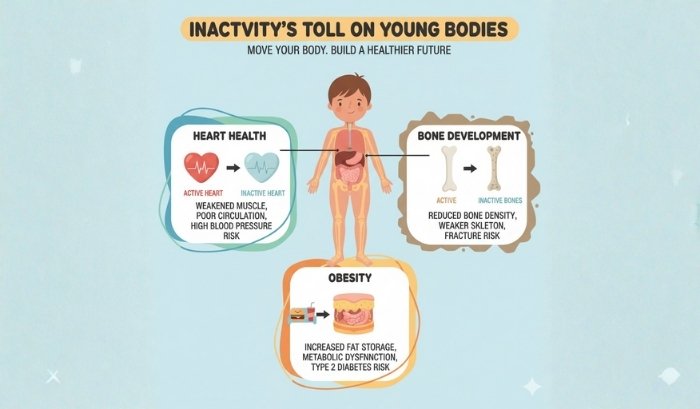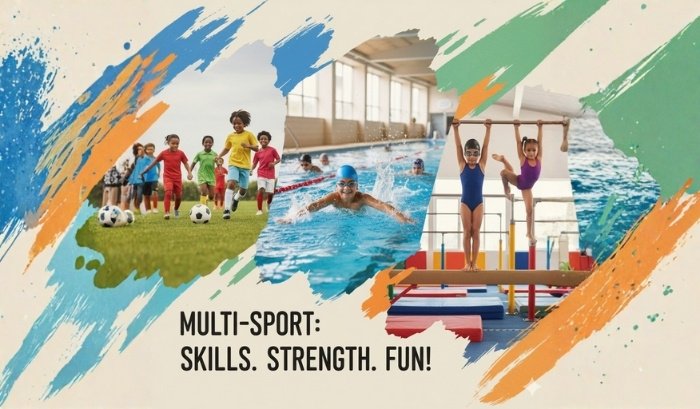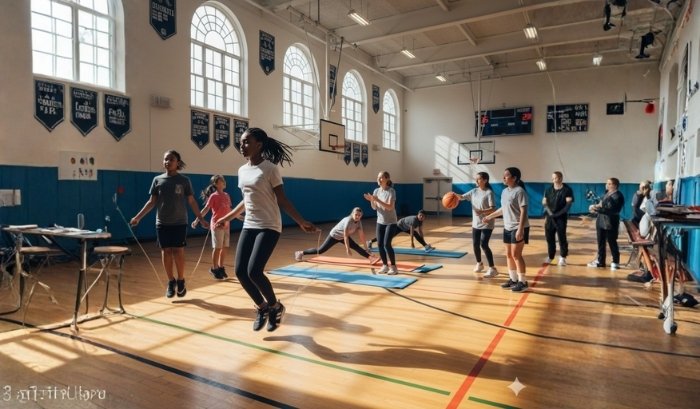The physical fitness of children and adolescents is declining at an alarming rate, sparking concern among parents, educators, and health experts worldwide. This decline is not due to a single cause but a complex mix of societal shifts, technological advancements, and changing lifestyles. Essentially, a combination of increased sedentary behavior and decreased opportunities for physical activity is putting the long-term health of our youth at risk.
This article will explain why there is a growing concern over the physical fitness of children and adolescents. We will explore the key factors driving this trend, from the rise of technology to the reduction in school-based physical education. We will also discuss the serious health implications and outline practical solutions for parents, schools, and communities.
Table of Contents
Why the Growing Concern Over Youth Physical Fitness?

The concern stems from alarming data showing a sharp rise in sedentary lifestyles and related health problems among young people. Authoritative bodies like the World Health Organization (WHO) and the Centers for Disease Control and Prevention (CDC) have published extensive research highlighting this trend. For example, the WHO reports that over 80% of adolescents worldwide do not meet the recommended guidelines for daily physical activity. This lack of physical fitness is directly linked to a surge in childhood obesity and the early onset of chronic diseases once only seen in adults. The issue is no longer just about being “out of shape”; it’s a public health crisis with long-term consequences for future generations.
The Health Implications: More Than Just Weight Gain

When we talk about the decline in physical fitness, the conversation often starts with obesity, and for good reason. The WHO notes a dramatic increase in childhood obesity over the past few decades. However, the health risks extend far beyond weight.
Key Health Risks for Inactive Children and Adolescents:
- Type 2 Diabetes: Once known as adult-onset diabetes, this condition is now increasingly diagnosed in young people due to poor diet and lack of exercise.
- Cardiovascular Issues: High blood pressure and elevated cholesterol levels are becoming more common in adolescents, setting the stage for heart disease later in life.
- Mental Health Struggles: Regular physical activity is a powerful tool for managing stress, anxiety, and depression. A sedentary lifestyle can worsen these conditions.
- Poor Bone Development: Weight-bearing activities are crucial for building strong bones. Inactivity during the critical growth years can lead to a higher risk of osteoporosis in adulthood.
- Weakened Immune System: Moderate, consistent exercise helps bolster the immune system, while a lack of it can leave children more susceptible to illnesses.
These health implications underscore why the declining physical fitness of children and adolescents is a major concern. It affects their current well-being and sets a precedent for a lifetime of potential health challenges.
The Role of Technology: A Double-Edged Sword
It’s impossible to discuss modern youth without mentioning technology. Digital devices, from smartphones and tablets to gaming consoles, have become central to their lives. While technology offers incredible benefits for learning and connection, it is also a primary contributor to sedentary behavior.
Data from various studies indicate that children and adolescents can spend several hours per day in front of screens. This screen time directly displaces time that could be spent on active play. The immersive nature of video games and social media makes it difficult for physical activity to compete for their attention. This creates a cycle where inactivity becomes the norm, further diminishing their overall physical fitness.
However, technology isn’t solely a villain. Innovative apps and “exergames” that encourage movement present an opportunity to use technology as a solution. The key is finding a balance.
A Personal Story: Navigating Youth Sports and Development
As a youth sports coach for over a decade, I’ve seen the pressure for early specialization firsthand. I recall a father, a former competitive basketball player, who wanted his 6-year-old son to focus exclusively on basketball. His goal was to give his son a head start.
I had to explain that at 6, a child’s body and mind are still in the early stages of development. Their nervous system is just beginning to master basic coordination, and their bones have active growth plates that are vulnerable to overuse injuries. Pushing a single sport too early often leads to burnout, social isolation, and injury, not elite performance.
Instead, I recommended a Long-Term Athlete Development (LTAD) approach. For his son, this meant focusing on fun, unstructured play and participating in a variety of activities like swimming, soccer, and gymnastics. This strategy builds a broad foundation of motor skills—running, jumping, throwing, and catching—that are essential for any sport later on. It also keeps the child engaged and prevents the mental fatigue that comes with intense, repetitive training at a young age.
Two years later, that same boy was a confident and coordinated 8-year-old who excelled in multiple sports. He eventually chose to pursue basketball, but with a more resilient body and a genuine love for the game that he developed on his own terms. This experience reinforces that a holistic approach to youth physical fitness is far more effective than early specialization.
What I Like: Strengths of a Multi-Sport Approach

- Develops a Wide Range of Motor Skills: Exposure to different sports improves agility, balance, and coordination more effectively than specializing in one.
- Reduces Risk of Overuse Injuries: Varying the physical demands on a child’s body prevents stress on specific muscles and joints, which is a common issue in single-sport athletes.
- Prevents Burnout: Variety keeps sports fun and engaging, reducing the mental and physical exhaustion that can lead to children quitting sports altogether.
- Enhances “Physical Literacy”: Children learn to move their bodies with confidence and competence in various settings, a skill that supports a lifetime of activity.
- Fosters Social Skills: Playing on different teams with different groups of peers helps develop adaptability and communication skills.
For a deeper dive into the origins, benefits, and styles of yoga and Everything You Need to Know About Yoga, check out this detailed guide in articles gogonihon.jp.net, mumbaitimes.net or ponta.in
Areas for Improvement: The Challenges of Early Specialization
- Increased Injury Risk: Repetitive movements can strain developing bones, joints, and muscles.
- Mental Burnout: The pressure to perform can turn a fun activity into a stressful obligation.
- Limited Skill Development: Focusing on one sport can lead to a narrow set of motor skills.
- Social Isolation: Intense training schedules can limit time for unstructured play and socializing with friends outside of the sport.
Key Factors Driving the Decline in Physical Fitness
Several interconnected factors contribute to the decline in youth fitness. Understanding them is the first step toward creating effective solutions.
1. The Shrinking Role of School Physical Education

School Physical Education Programs were once a cornerstone of a child’s weekly activity. Today, many schools have been forced to cut back on PE classes due to budget constraints and an increased focus on standardized testing. The CDC recommends that children and adolescents get at least 60 minutes of moderate-to-vigorous physical activity daily. Unfortunately, a significant portion of this is no longer happening during the school day.
When PE is offered, it’s often not long enough or intense enough to provide significant health benefits. This reduction not only decreases a child’s total activity level but also sends a message that physical fitness is less important than academics.
2. The Powerful Influence of Parents and Home Life
Parental influence is one of the most significant factors in a child’s activity level. Parents act as role models, and their habits—whether active or sedentary—are often mirrored by their children. An active family that prioritizes walks, bike rides, or playing sports together is more likely to raise active children.
Conversely, if family life revolves around screen time and inactivity, children will adopt these behaviors. The choices parents make regarding nutrition, screen time limits, and encouragement for active play are crucial. Creating a home environment that supports a healthy lifestyle is fundamental to combating the trend of declining youth fitness.
3. The Impact of Community and Environment
The environment where a child lives also plays a critical role. Many communities lack safe and accessible spaces for play, such as parks, playgrounds, and bike paths. In some urban areas, safety concerns keep children indoors.
Community programs, such as local sports leagues, after-school clubs, and recreational centers, can help fill this gap. These programs provide structured, safe, and supervised opportunities for physical activity. When communities invest in these resources, they provide an essential support system for families and help make an active lifestyle more achievable for all children and adolescents.
Comparing Approaches to Youth Athletic Development
When considering how to engage children in sports, parents and coaches often debate between early specialization and a multi-sport model. The Long-Term Athlete Development (LTAD) framework provides a research-backed guide for this decision.
| Feature | Early Specialization | Multi-Sport (LTAD) Model |
|---|---|---|
| Primary Goal | Achieve elite performance in one sport quickly. | Build a foundation for lifelong physical activity and peak performance at maturity. |
| Age of Focus | Intensive, sport-specific training often starts before age 12. | Emphasis on fundamental movement skills and diverse sports until puberty. |
| Injury Risk | Higher risk of overuse injuries and burnout. | Lower risk of injury due to varied movements and less repetitive stress. |
| Psychological Impact | Can lead to stress, pressure, and loss of interest. | Fosters a love for sport and reduces the risk of burnout. |
| Long-Term Success | May produce early success, but many athletes drop out before reaching their potential. | Higher likelihood of sustained participation and reaching peak performance in late adolescence. |
This comparison makes it clear that for most children and adolescents, the LTAD model offers a healthier and more sustainable path to both athletic success and lifelong physical fitness.
Frequently Asked Questions (FAQ)
1. How much physical activity do children and adolescents need?
The CDC and WHO recommend that children and adolescents aged 6 to 17 years do 60 minutes or more of moderate-to-vigorous physical activity daily. This should include aerobic activity, muscle-strengthening exercises, and bone-strengthening activities.
2. Is early sports specialization bad for my child?
While it can lead to success in some sports (like gymnastics), early specialization generally increases the risk of injury, burnout, and psychological stress. Most experts, guided by the Long-Term Athlete Development (LTAD) model, recommend a multi-sport approach until at least age 12-14.
3. What can parents do to encourage more physical activity?
Parental influence is key. Parents can be active role models, limit screen time, provide toys that encourage activity (like balls and bikes), and plan active family outings. Making physical activity a fun and regular part of family life is crucial.
4. How can schools help improve student physical fitness?
Schools can prioritize School Physical Education Programs, ensuring students receive quality PE daily. They can also integrate short activity breaks into classroom time, offer after-school sports, and create safe routes for walking or biking to school.
5. What is the link between physical fitness and mental health?
There is a strong, positive link. Regular physical activity releases endorphins, which improve mood and reduce feelings of stress and anxiety. It can also improve self-esteem and cognitive function, helping children perform better in school.
6. How does diet affect a child’s physical fitness?
Diet and physical fitness are two sides of the same coin. A balanced diet provides the energy needed for activity and the nutrients required for growth and muscle repair. Diets high in processed foods and sugar contribute to obesity and poor health, regardless of activity levels.
7. Where can I find community programs for my child?
Check with your local parks and recreation department, YMCA, Boys & Girls Clubs, or local youth sports organizations. These community programs offer a wide range of affordable and accessible activities for children of all ages and abilities.
If you’re looking for professional web development, SEO services, digital marketing, content marketing, link building, or guest posting, please visit or contact LinkLuminous.com. And if you want to purchase high-quality products online, check out TokyoMart.store for great deals and a wide selection.
Conclusion: A Collective Responsibility for a Healthier Future
To explain why there is a growing concern over the physical fitness of children and adolescents is to recognize a public health crisis in the making. The combination of rampant technology use, declining School Physical Education Programs, and increasingly sedentary lifestyles has created a perfect storm. The consequences, including rising obesity and mental health issues, demand immediate and collective action.
The solutions lie in a coordinated effort. Parents must champion active lifestyles through their own behavior and encouragement. Schools need to restore physical education to its rightful place in the curriculum. Communities must invest in safe, accessible spaces and programs that make activity possible for every child.
By embracing a holistic approach like the Long-Term Athlete Development model and leveraging the expertise of organizations like the CDC and WHO, we can reverse this trend. The goal is not just to create elite athletes but to raise a generation of healthy, resilient, and active individuals. It’s time to work together to ensure our children and adolescents have the foundation they need for a long and healthy life.
About the Author
Dr. Evelyn Reed is a pediatric sports medicine physician and youth wellness advocate with over 15 years of experience. She holds a Ph.D. in Kinesiology and works with young athletes to promote safe and sustainable physical development. Dr. Reed frequently consults with schools and community organizations to design effective youth fitness programs, drawing on guidelines from the CDC and WHO to inform her evidence-based approach.
References
- World Health Organization (WHO). “Physical activity.”
- Centers for Disease Control and Prevention (CDC). “Physical Activity Facts.”
- International Olympic Committee (IOC). “Consensus Statement on Youth Athletic Development.”

